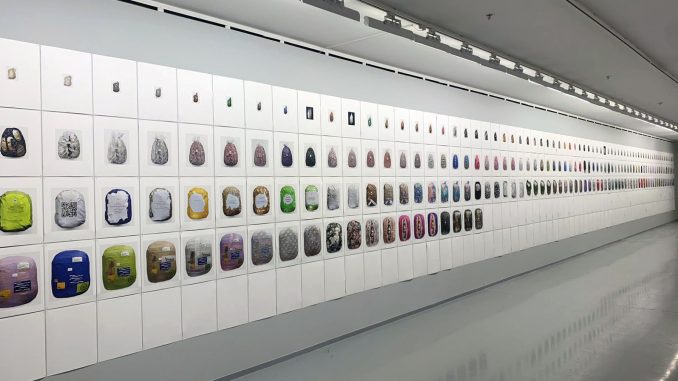
MishMash, “The Wrapper 361,” 2021. Wood, mixed media. (Courtesy: MishMash Art Group).
New forms appear in the art world, and sometimes, it is hard to understand the dividing line between the physical and ethereal. Art’s transformation from a real object to an NFT signifies something more than just a reproduction of an art piece in a digital form; it is, instead, a creation of an art piece from the very properties of art, including one of its most ephemeral–time. Misha Leykin and Masha Sumnina, the members of the MishMash art group based in Rome and Berlin, never stop their interrogation of new artistic forms. Fine Art Globe spoke with MishMash to learn how the soap sculpture affects visitors of the meat pastry eatery, why their often self-destructive art is good for the environment, and how to grow an NFT each day for a whole year.
Veronika Georgieva: In your artistic practice, you often invent a ritual: for example, from August 2010 to July 2011, you kept a diary every day, recording not only what was happening in the world but also your weight, pressure, and temperature, then you drew a line a day, every day, for the entire year of 2015, and, for the whole year of 2021, you wrapped a particular object in different materials. Is ritual a territory of peace and security for you?
MishMash: Yes, of course it is. It’s a way to look at yourself and everything from a distance, to detach yourself. This seems to be what art is for – translating reality into a different plane, taking yourself out of it, and then trying to see its construction. We are mesmerized by the repetition effect – how the repetition of the same thing changes its essence, erases, and transforms it.
VG: But you take not only yourself out, but also the viewer – inventing a ritual to put it in viewers’ hands–literally–when you made the eatery’s visitors wash their hands not with ordinary soap, but with a soap sculpture of Venus. Who came up with the idea to do such a project in the eatery?

MishMash, “Venus,” 2011. Soap, human effort eatery “Friendship.” (Courtesy: MishMash).
MM: The birth of this project was magically instantaneous. One day, just for fun, we went into a counterfeit goods store. And there, on the floor, we noticed a basket filled with naked-pink soap without a wrapper. The chunks were slightly uneven and very flesh-colored. It became immediately clear – we had to buy it. And as we were leaving the store, we realized that we must cast a figure of Venus from it. Somehow, almost at the same time, curators Oksana Sarkisyan and Vika Begalskaya invited us to participate in their exhibition project, “Che,” in an eatery called “Friendship.” It is the oldest one in Moscow, and it serves only chebureks, a deep-fried turnover with a filling of ground or minced meat and onions, an every-day dish typical to Central Asian and Crimean Tatar cuisine. Everything came together–Venus naturally took her place at the sink in the hall of the eatery, and cheburek-eaters began to push Venus with their own hands through the history of art, washing out her shape from the sharpness of antiquity to the smoothness of modernism. Some, though, worked furiously trying to penetrate the statue. The chef fiercely defended her by performing plastic surgery and patching holes (both necessary and unnecessary). The time flew a little differently at the eatery as if everyone there were adherents of an ancient cult, and the appearance of Venus was utterly natural. No one paid attention to the video shooting of the process either.
VG: The visitors probably seemed to be followers of an ancient cult because the cheburek itself is something from the past. And by suggesting that the cheburek’s grease will be washed off their hands with pink Venus soap, you have only strengthened the cult’s image by adding an explicit ritualistic action.
But back to the notion of time. Generally, artists are determined to make their works as durable as possible, to keep them intact for as long as possible; however, your work is often deliberately self-destructive. Why?
MM: First, it makes the viewer empathize and appreciate them right now. Second, it solves the problem of overcrowding the space. Third, it’s humility. Fourth, we like the sense of process and learning new things. If you’re making something timeless, the meaning can change, but the thing stays the old way. We are generally hypnotized by the magic of time, so we often try to flirt with it.
VG: By overcrowding of space, do you mean an overabundance of production in the physical world?
MM: That, and, these days especially, information overproduction, which is also compounded by unfortunate events in the world that have generated pathological amount of words and reasoning.

MIshMash, “The Wrapper 1,” 2021. Wood. (Courtesy: MishMash).
VG: What about your projects with NFT production? Don’t you think that it also clogs up the information space?
MM: NFT is a unique file – a person buys and keeps it for himself. It is a kind of information unit that may not be dumped on the viewer without asking. I will tell you about our constantly reborn project, which we turned into NFT: it’s called “Over&Over.” When the pandemic started, we were all faced with a massive amount of time to spend while in the lockdown, time many of us didn’t know what to do with, and most importantly, when it would end. Time is both something that scares and something that comforts. When we find ourselves facing uncontrollable forces, time is the only thing we can count on. It can turn a shock into a routine. Sometimes, we struggle to shove it through us, but it also softens the sharp edges. Everything around us counts down from something to something.
Therefore, from January 1 until December 31, 2021, every day, we packed anew a wooden figurine of digit 1, building up layers from improvised materials. At the end of the year, we got one object with precise dimensions of 8 kg 650 g in weight and 44 by 30 by 36 cm in size. But all of the 365 sculptures were reflected in and documented by the photographs we took daily and posted on social networks. For a couple of months, the whole process could be observed in the Moscow Multimedia Art Museum, where new photos were added to the wall every day so that you could see all the stages of the transformation, all the layers.
Every day, we were overcome with the artist’s regret because each new layer hid the previous work forever: some were deeply missed! But this experience was meaningful as self-education and self-irony. It seems to us that it is essential for an artist not to get stuck in one style or idea and the feeling of his extreme importance.
At the same time, the whole thing had an active life and a lot of fans, and we made a radio play out of their comments. Some people contributed by giving us materials. Thank you for the patterns – a whole week was in your name!
In 2023, we explored a new form of reincarnation of “The Wrapper” – as we call it among ourselves. Obviously, such a thing had to be turned into an NFT–a unique digital image, because all these 364 images of its layers–as one-day sculpture, are available only digitally, and only the last layer, hiding under itself all the others, is available in the material world. So, on 01/01/2023, we started to make NFTs of these 365 images in sequence and post them one by one on Rarible every day. And every day, we accompany the creation of NFTs with the creation of Instagram stories, which, as you know, only live for 24 hours. Soon, the year will be over, and the entire sequencing will be available in NFT. And then it will start to disappear if it is not purchased–according to Rarible’s rules.

MishMash Art Group, “The Wrapper 233,” 2021. Wood, mixed media. (Courtesy: MishMash).
VG: “The Wrapper” increased in size every day, and this can also be attributed to your self-destructive projects – because every next day, it did not shed but hid its old “skin” and never resembled its yesterday’s self. I remember when I came to Moscow and saw it after a whole year of watching its changes in social networks– saw it already in its final self– I took it in my arms and experienced something like awe as if I were really taking something alive, a baby… I wonder why that is so? Watching someone, something growing, touch your soul with a feeling of belonging? And you begin to become enveloped with love even for an inanimate object? And it wasn’t just for me – “The Wrapper” had a lot of fans. It was adored.
But what do you mean it’s going to start disappearing? Is it the Rarible’s rules? In pieces or all of them? And when? Can you buy one day of “The Wrapper” now or the whole collection? It would make a nice gift for the new year. Can I give NFTs as gifts? And in what proportions does the price go up every day?
MM: Yes, “The Wrapper” practically acquired a personality. It was not just a subject of our author’s arbitrary behavior, but it was also connected with viewers and subscribers; it reacted to external events as best it could, and it had moments of self-reflection. It mirrored reality. Well, in fact, it continues now, turning into NFT. Each token has an expiration date according to Rarible’s rules. They give a maximum of 6 months for a token, so if it’s not bought, it will disappear. Its price is formed in the simplest way possible: the number of day of the week corresponds to the price. But in terms of value, there are some surprises: while digits connect with a number of the day, the value depends on a virtual currency.
VG: While we are speaking on Zoom, I see that you are wrapping something else, a big rock. What is it for?
MM: This is a part of the installation for our upcoming exhibition at Maxim Bokser Gallery in Riga. It is going to be a solo show based on time, space, and stones.
VG: Although it’s very big, it seems weightless–you are moving it around very easily!
MM: Because we are very strong! And we can easily convert paper into stone and time into art into NFT.
VG: Good luck with all the conversions!











